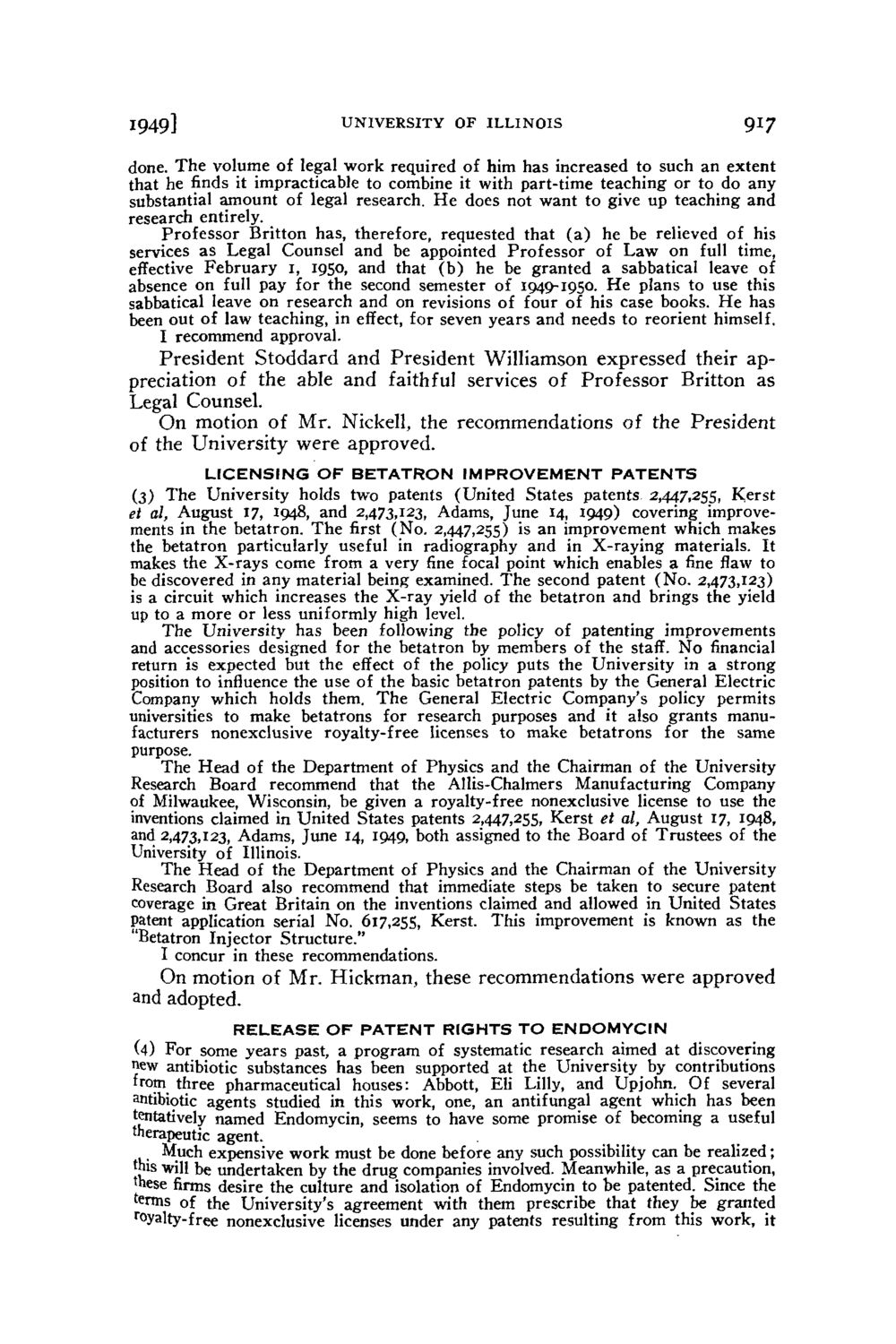| |
| |
Caption: Board of Trustees Minutes - 1950
This is a reduced-resolution page image for fast online browsing.

EXTRACTED TEXT FROM PAGE:
1949] UNIVERSITY OF ILLINOIS 917 done. The volume of legal work required of him has increased to such an extent that he finds it impracticable to combine it with part-time teaching or to do any substantial amount of legal research. He does not want to give up teaching and research entirely. Professor Britton has, therefore, requested that (a) he be relieved of his services as Legal Counsel and be appointed Professor of Law on full time, effective February 1, 1950, and that (b) he be granted a sabbatical leave of absence on full pay for the second semester of 1049-1950. He plans to use this sabbatical leave on research and on revisions of four of his case books. He has been out of law teaching, in effect, for seven years and needs to reorient himself. I recommend approval. President Stoddard and President Williamson expressed their appreciation of the able and faithful services of Professor Britton as Legal Counsel. On motion of Mr. Nickell, the recommendations of the President of the University were approved. LICENSING OF BETATRON IMPROVEMENT PATENTS (3) The University holds two patents (United States patents 2,447,255, Kerst et al, August 17, 1048, and 2,473,123, Adams, June 14, 1949) covering improvements in the betatron. The first (No. 2,447,255) is an improvement which makes the betatron particularly useful in radiography and in X-raying materials. It makes the X-rays come from a very fine focal point which enables a fine flaw to be discovered in any material being examined. The second patent (No. 2,473,123) is a circuit which increases the X-ray yield of the betatron and brings the yield up to a more or less uniformly high level. The University has been following the policy of patenting improvements and accessories designed for the betatron by members of the staff. No financial return is expected but the effect of the policy puts the University in a strong position to influence the use of the basic betatron patents by the General Electric Company which holds them. The General Electric Company's policy permits universities to make betatrons for research purposes and it also grants manufacturers nonexclusive royalty-free licenses to make betatrons for the same purpose. The Head of the Department of Physics and the Chairman of the University Research Board recommend that the Allis-Chalmers Manufacturing Company of Milwaukee, Wisconsin, be given a royalty-free nonexclusive license to use the inventions claimed in United States patents 2,447,255, Kerst et al, August 17, 1948, and 2,473,123, Adams, June 14, 1949, both assigned to the Board of Trustees of the University of Illinois. The Head of the Department of Physics and the Chairman of the University Research Board also recommend that immediate steps be taken to secure patent coverage in Great Britain on the inventions claimed and allowed in United States patent application serial No. 617,255, Kerst. This improvement is known as the "Betatron Injector Structure." I concur in these recommendations. On motion of Mr. Hickman, these recommendations were approved and adopted. RELEASE O F PATENT RIGHTS TO ENDOMYCIN (4) For some years past, a program of systematic research aimed at discovering new antibiotic substances has been supported at the University by contributions from three pharmaceutical houses: Abbott, Eli Lilly, and Upjohn. Of several antibiotic agents studied in this work, one, an antifungal agent which has been tentatively named Endomycin, seems to have some promise of becoming a useful therapeutic agent. Much expensive work must be done before any such possibility can be realized; this will be undertaken by the drug companies involved. Meanwhile, as a precaution, these firms desire the culture and isolation of Endomycin to be patented. Since the terms of the University's agreement with them prescribe that they be granted r oyalty-free nonexclusive licenses under any patents resulting from this work, it
| |